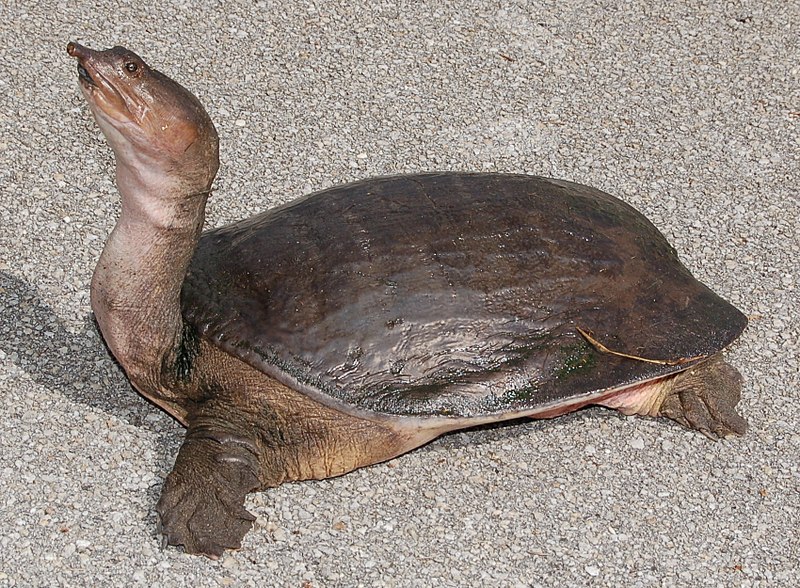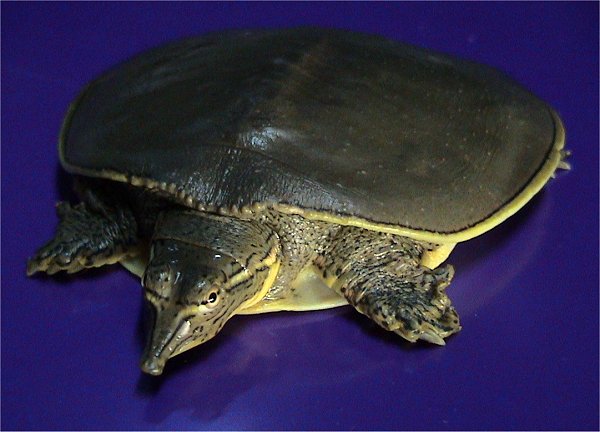 Softshell Turtles caught my attention early and remain great favorites of mine all these years (decades!) later. I’ve had a long history with the group – I raised Smooth Softshell hatchlings as a child, dove with huge Florida Softshells in southern canals and was eventually lucky enough to work with the immense Narrow-Headed and Bibron’s Giant Softshells. Today I’d like to introduce this most unique turtle family.
Softshell Turtles caught my attention early and remain great favorites of mine all these years (decades!) later. I’ve had a long history with the group – I raised Smooth Softshell hatchlings as a child, dove with huge Florida Softshells in southern canals and was eventually lucky enough to work with the immense Narrow-Headed and Bibron’s Giant Softshells. Today I’d like to introduce this most unique turtle family.
Natural History
Twenty four species of Softshell Turtles, all classified within the family Trionychidae, are found in Africa, North America (where 3 species occur) and Asia (they range to New Guinea, but have not reached Australia).
All are highly aquatic, and their flattened, leathery shells and paddle-like feet render them amazingly fast swimmers. Most spend a good deal of time partially buried in sand or mud, and they can disappear into such substrates as quickly as they move through water.
Long snouts help Softshells to breath without leaving the sand into which they have burrowed…by extending their necks to the surface, they can take in air while remaining hidden.
Diet
The largely carnivorous Softshell Turtles take nearly any creature they can overpower, and their strike rivals that of any snake in speed; fishes, insects, snails, crayfishes, frogs, tadpoles, salamanders and carrion are all on the menu. The flattened mouth ridges seen in some species may be an adaptation to crushing mussels and other mollusks.
While field research is lacking, my observations lead me to believe that muskrats, ducks and larger game are taken on occasion.
Keeping Softshells
 Softshell Turtles make interesting captives, but females of most species grow far too large for the average aquarium. Water quality is of paramount importance, far more so than for most turtles. Softshells kept in sub-optimal conditions invariably develop serious fungal infections that are difficult to treat. Strong filtration and frequent water changes are essential – I advise keepers to treat Softshells as they would aquatic amphibians or fishes.
Softshell Turtles make interesting captives, but females of most species grow far too large for the average aquarium. Water quality is of paramount importance, far more so than for most turtles. Softshells kept in sub-optimal conditions invariably develop serious fungal infections that are difficult to treat. Strong filtration and frequent water changes are essential – I advise keepers to treat Softshells as they would aquatic amphibians or fishes.
Males are by far the better choice as pets, as they are much the smaller sex. While female Florida Softshells (Apalone ferox) have topped 70 pounds in weight, males may mature at a mere 6 inches long. Male Smooth (Apalone mutica) and Spiny Softshells (A. spinifera) are, at 4-6 inches, so much smaller than females as to appear to be of another species.
Be Careful…some sad stories
Softshell Turtles are very prone to shell injuries when kept on rough substrates…in my experience these become infected with extraordinary speed, and often prove fatal even with treatment. Sand or smooth pea gravel is best.
I still recall with great sadness 2 Narrow-Headed Softshells (Chitra indica) that expired during my years as a zookeeper due to injuries caused by an inappropriately-designed exhibit. Several huge Spiny Softshells that lived for decades in the Brooklyn Botanical Gardens koi pond (much to the chagrin of the koi!) apparently met the same fate when moved during a renovation.
I’ve read reports of a 96 pound Florida Softshell that was captured in Florida and died from plastron injuries when it was stored improperly (I tried to see that animal but unfortunately was too late).
Softshells generate more stories than most turtles – from boat-attacking behemoths to temple guardians, they figure prominently in the lores of many countries. The habits of many are also a mystery…I’ll touch on these topics in Part II.
Further Reading
An overview of the group and accounts of all species is available here.
Florida Softshell Turtle image referenced from wikipedia and originally posted by Johnskate 17
Spiny Softshell Turtle image referenced from wikipedia and originally posted by LA Dawson
 That Reptile Blog – Reptile, Amphibian and Exotic Pet Care and Information
That Reptile Blog – Reptile, Amphibian and Exotic Pet Care and Information




My girlfriend rescued a Florida soft-shell from a parking lot today. It was injured. I called a ver emergency clinic and was told the carry a lot of bacteria and to leave it. Too late for that, my girlfriend brought it home already. Any suggestions on what to do?
Hello Bryan,
If you are in Florida (the Fla softshell ranges outside of the state), try calling Turtle Rescue USA; they may be able to direct you to a another center, if location is not convenient. Also check for a reptile society within your state on this list ; many take in turtles or know of local co-operating vets.
Salmonella is a concern with any reptile, but can be avoided with proper hygiene; please see this article for further info. Be sure to stay away from the head – they can inflict severe bites, and strike very quickly. Until you find some help, you can house it in a plastic storage bin or similar container, in shallow water. A dark location will keep the turtle calmer.
They rarely travel far from water unless nesting, so you may have a female that need to lay eggs; injuries/cuts become infected quickly, so vet attention should be given asap; mention that the animal was found on land, so the vet can check for eggs.
Please let me know if you need further info, and how it turns out, Best, Frank
Thanks for the links and info, and yes, I am in Florida. I already put it in a plastic tub with water, and in a dark place. I have 4 snakes and a Savannah monitor, so I am familiar with the salmonella risks. My main concern is the turtle’s recovery, since everything I have read says they tend to get infections quickly. Luckily I have tomorrow off and can take time to contact Turtle Rescue USA.
Great, Bryan, thanks for the feedback.
They do seem very infection prone, with shell and skin lesions being a real concern; infections there seem to become septic, internally, very quickly. Here in NYC, I was involved with food trade Florida softshells for some time, and rarely found one in good shape. Several feral animals were lost to infections when a group tried to re-locate them from a lake in Brooklyn (where they over wintered without ill effect); same, as far as I know, with the huge (app 92lb) female caught in central Fla some years ago. The plastron and under-skin abrades very easily – retraining the animal in a wet blanket may be safer than transporting in plastic with water, as it may bounce around/try to escape at that time. Please keep me posted, good luck, Frank